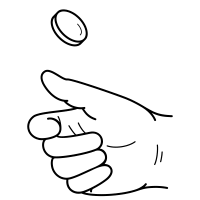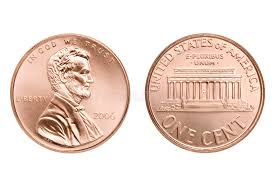Science > Mathematics > Statistics and Probability > Probability > Problems Based on Tossing of Coins

In the last few articles, we have studied the basic concepts of probability. In this article, we are going to study problems based on the tossing of coins.
Algorithm:
- Study experiment and write the sample space
- Find favourable point and write event space
- Use the definition of probability and find it.
Tossing of a Single Coin:
Example 01:
A fair coin is tossed once. Find the probability of getting
| a) a Head | b) a tail |
| c) not the head | d) not the tail |
| e) Head or tail | f) Head and tail |
A fair coin is tossed.
The sample space is S = {H, T} and n(S) = 2
a) Getting a head
Let A be an event of getting head
A = {H} and n(A) = 1
By definition of probability
P(A) = n(A)/n(S) = 1/2
Ans: Thus the probability of getting head is 1/2
b) Getting a tail
Let B be an event of getting tail
B = {T} and n(B) = 1
By definition of probability
P(B) = n(B)/n(S) = 1/2
Ans: Thus the probability of getting tail is 1/2
c) Getting not the head
Let C be an event of getting not head
C = {T} and n(C) = 1
By definition of probability
P(C) = n(C)/n(S) = 1/2
Ans: Thus the probability of getting not head is 1/2
d) Getting not the tail
Let D be an event of getting not tail
D = {H} and n(D) = 1
By definition of probability
P(D) = n(D)/n(S) = 1/2
Ans: Thus the probability of getting not tail is 1/2
e) Getting the head or the tail
Let E be an event of getting the head or the tail
E = {H, T} and n(E) = 2
By definition of probability
P(E) = n(E)/n(S) = 2/2 = 1
Ans: Thus the probability of getting the head or the tail is 1
Note: It is a certain event
f) Getting the head and the tail
Let F be an event of getting the head and the tail
F = {} and n(F) = 0
By definition of probability
P(F) = n(F)/n(S) = 0/2 = 0
Ans: Thus the probability of getting the head and the tail is 0
Note: It is an impossible event
Tossing of Two Coins:
A fair coin is tossed two times is equivalent to two fair coins are tossed.
The sample space is
S = {HH, HT, TH, TT}
n(S) = 4
Example – 02:
Two unbiased coins are tossed. Find the probability of getting OR A fair coin is tossed two times. Find the probability of getting
| a) Exactly one head | b) Atleast one head |
| c) at most one head | d) both head |
| e) No head | f) no head on the first coin |
| g) no head on the second coin | h) Head on one coin and tail on the other |
| i) Head on the first coin and the tail on the other |
Solution:
Two unbiased coins are tossed or a fair coin tossed twice.
The sample space for the experiment is
S = {HH, HT, TH, TT}
∴ n(S) = 4
a) Exactly one head
Let A be the event of getting exactly one head
∴ A = {HT, TH}
∴ n(A) = 2
By the definition P(A) = n(A)/n(S) = 2/4 = 1/2
Ans: the probability of getting exactly one head is 1/2
b) at least one head
Let B be the event of getting at least one head i.e. one head or two head
∴ B = {HH, HT, TH}
∴ n(B) = 3
By the definition P(B) = n(B)/n(S) = 3/4
Ans: the probability of getting at least one head is 3/4
c) at the most one head
Let C be the event of getting at most one head i.e. no head or one head
∴ C = {HT, TH, TT}
∴ n(C) = 3
By the definition P(C) = n(C)/n(S) = 3/4
Ans: the probability of getting at most one head is 3/4
d) both head
Let D be the event of getting both head
∴ D = {HH}
∴ n(D) = 1
By the definition P(D) = n(D)/n(S) = 1/4
Ans: the probability of getting both head is 1/4
e) no head
Let E be the event of getting no head
∴ E = {TT}
∴ n(E) = 1
By the definition P(E) = n(E)/n(S) = 1/4
Ans: the probability of getting no head is 1/4
f) no head on the first coin
Let F be the event of getting no head on the first coin
∴ F = {TH, TT}
∴ n(F) = 2
By the definition P(F) = n(F)/n(S) = 2/4 = 1/2
Ans: the probability of getting no head on first coin is 1/2
g) no head on the second coin
Let G be the event of getting no head on the second coin
∴ G = {HT, TT}
∴ n(G) = 2
By the definition P(G) = n(G)/n(S) = 2/4 = 1/2
Ans: the probability of getting no head on the second coin is 1/2
h) Head on one coin and tail on the other
Let H be the event of getting head on one coin and tail on the other
∴ H = {HT, TH}
∴ n(H) = 2
By the definition P(H) = n(H)/n(S) = 2/4 = 1/2
Ans: the probability of getting head on one coin and tail on the other is 1/2
i) Head on the first coin and the tail on the other
Let J be the event of getting head on the first coin and the tail on the other
∴ J = {HT}
∴ n(J) = 1
By the definition P(J) = n(J)/n(S) = 1/4
Ans: the probability of getting head on the first coin and the tail on the other is 1/4
Tossing of Three Coins:
A fair coin is tossed three times is equivalent to three fair coins are tossed.
The sample space is
S = {HHH, HHT, HTH, THH, HTT, THT, TTH, TTT}
n(S) = 8
Example – 03:
Three coins are tossed (OR A coin is tossed three times) and the results are recorded. Find the probabilities in the following events
Solution:
Three unbiased coins are tossed or a fair coin tossed thrice.
The sample space for the experiment is
S = {HHH, HHT, HTH, THH, HTT, THT, TTH, TTT}
∴ n(S) = 8
a) getting exactly one head
Let A be the event of getting exactly one head
∴ A = { HTT, THT, TTH}
∴ n(A) = 3
By the definition P(A) = n(A)/n(S) = 3/8
Ans: the probability of getting exactly one head is 3/8
b) getting exactly two heads
Let B be the event of getting exactly two heads
∴ B = {HHT, HTH, THH}
∴ n(B) = 3
By the definition P(B) = n(B)/n(S) = 3/8
Ans: the probability of getting exactly two heads is 3/8
c) getting all heads
Let C be the event of getting all heads
∴ C = {HHH}
∴ n(C) = 1
By the definition P(C) = n(C)/n(S) = 1/8
Ans: the probability of getting all heads is 1/8
d) getting two or more heads (at least two heads):
Let D be the event of getting atleast two heads i.e. getting two or three heads
∴ D = {HHH, HHT, HTH, THH}
∴ n(D) = 4
By the definition P(D) = n(D)/n(S) = 4/8 = 1/2
Ans: the probability of getting at least two heads is 1/2
e) getting no head:
Let E be the event of getting no head
∴ E = {TTT}
∴ n(E) = 1
By the definition P(E) = n(E)/n(S) = 1/8 = 1/
Ans: the probability of getting no head is 1/8
f) getting at least one head:
Let F be the event of getting atleast one head
p(atleast one head) = 1 – P(no head) = 1- 1/8 = 7/8
Ans: the probability of getting at least one head is 7/8
g) getting atmost one head:
Let G be the event of getting atmost one head i.e. getting no head or one head
G = {HTT, THT, TTH, TTT}
∴ n(G) = 4
By the definition P(G) = n(G)/n(S) = 4/8 = 1/2
Ans: the probability of getting atmost one head is 1/2
h) getting atmost two heads:
Let H be the event of getting atmost two head i.e. getting no head or one head
H = {HHT, HTH, THH, HTT, THT, TTH, TTT}
∴ n(H) = 7
By the definition P(H) = n(H)/n(S) = 7/8
Ans: the probability of getting atmost two heads is 7/8
i) getting head on second toss or second coin:
Let J be the event of getting head on second toss
J = {HHH, HHT, THH, THT}
∴ n(J) = 4
By the definition P(J) = n(J)/n(S) = 4/8 = 1/2
Ans: the probability of getting head on the second toss is 1/2
Tossing of Four Coins:
Example – 04:
Four coins are tossed and the results are recorded. Find the probabilities in the following events
Solution:
four unbiased coins are tossed the number of points in sample space for the experiment is
∴ n(S) = 24 = 16
a) getting exactly one head
Let A be the event of getting exactly one head
∴ A = { HTTT, THTT, TTHT, TTTH}
∴ n(A) = 4
By the definition P(A) = n(A)/n(S) = 4/16
Ans: the probability of getting exactly one head is 1/4
b) getting no head
Let B be the event of getting exactly one head
∴ B = { TTTT}
∴ n(B) = 1
By the definition P(B) = n(B)/n(S) = 1/16
Ans: the probability of getting exactly no head is 1/16
c) getting at least one head
Let C be the event of getting atleast one head
p(atleast one head) = 1 – P(no head) = 1- 1/16 = 15/16
Ans: the probability of getting at least one head is 15/16
In the next article, we shall study some basic problems of probability based on the tossing of a single die.

3 replies on “Problems Based on Tossing of Coins”
This is one of the best article and so descriptive and clear. Thank you so much
There’s a typo in Ex.4 c). The probability should be 15/16 instead of 17/16. Thank you for making this website!
Thank you for the correction, Answer corrected.